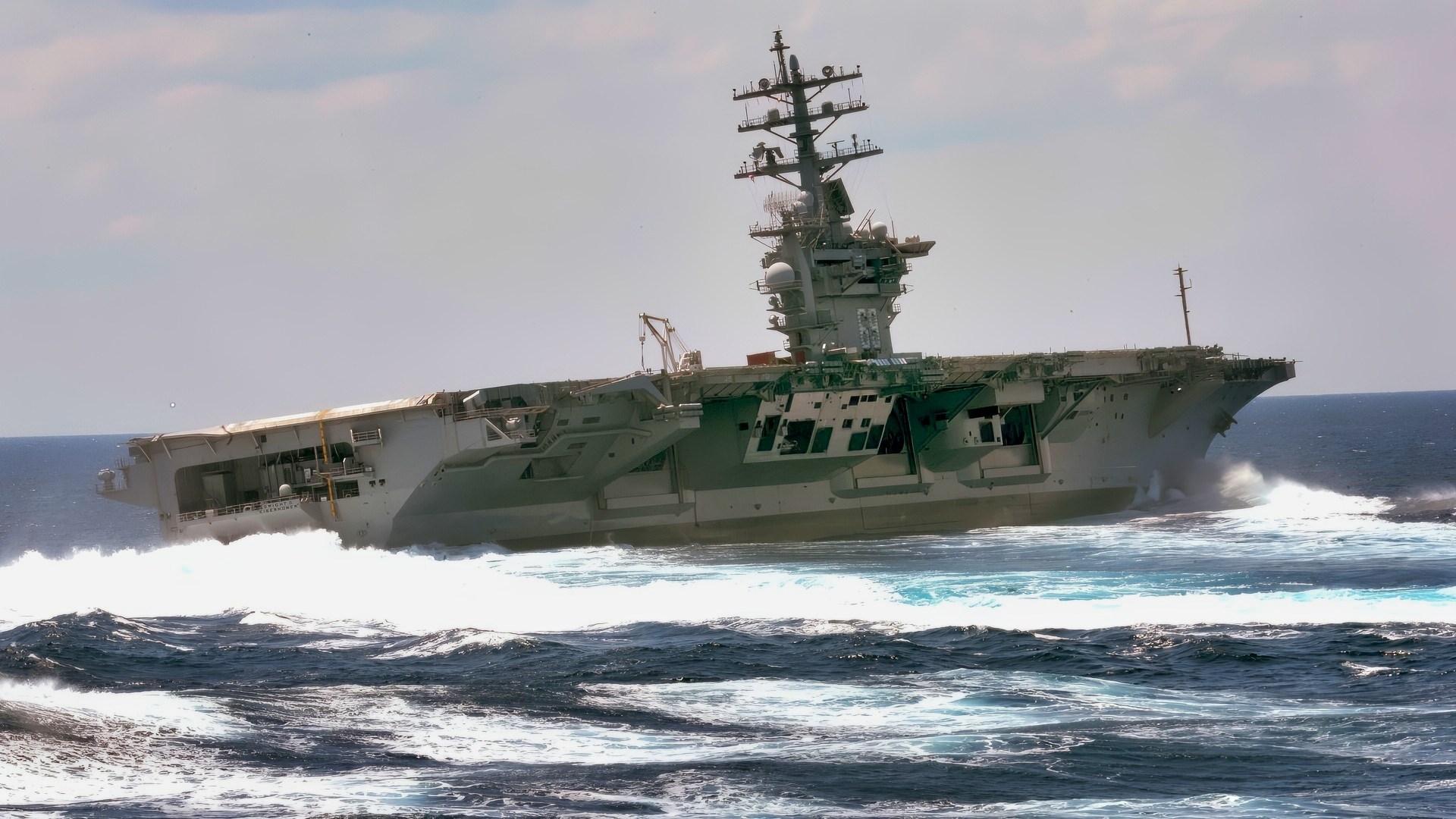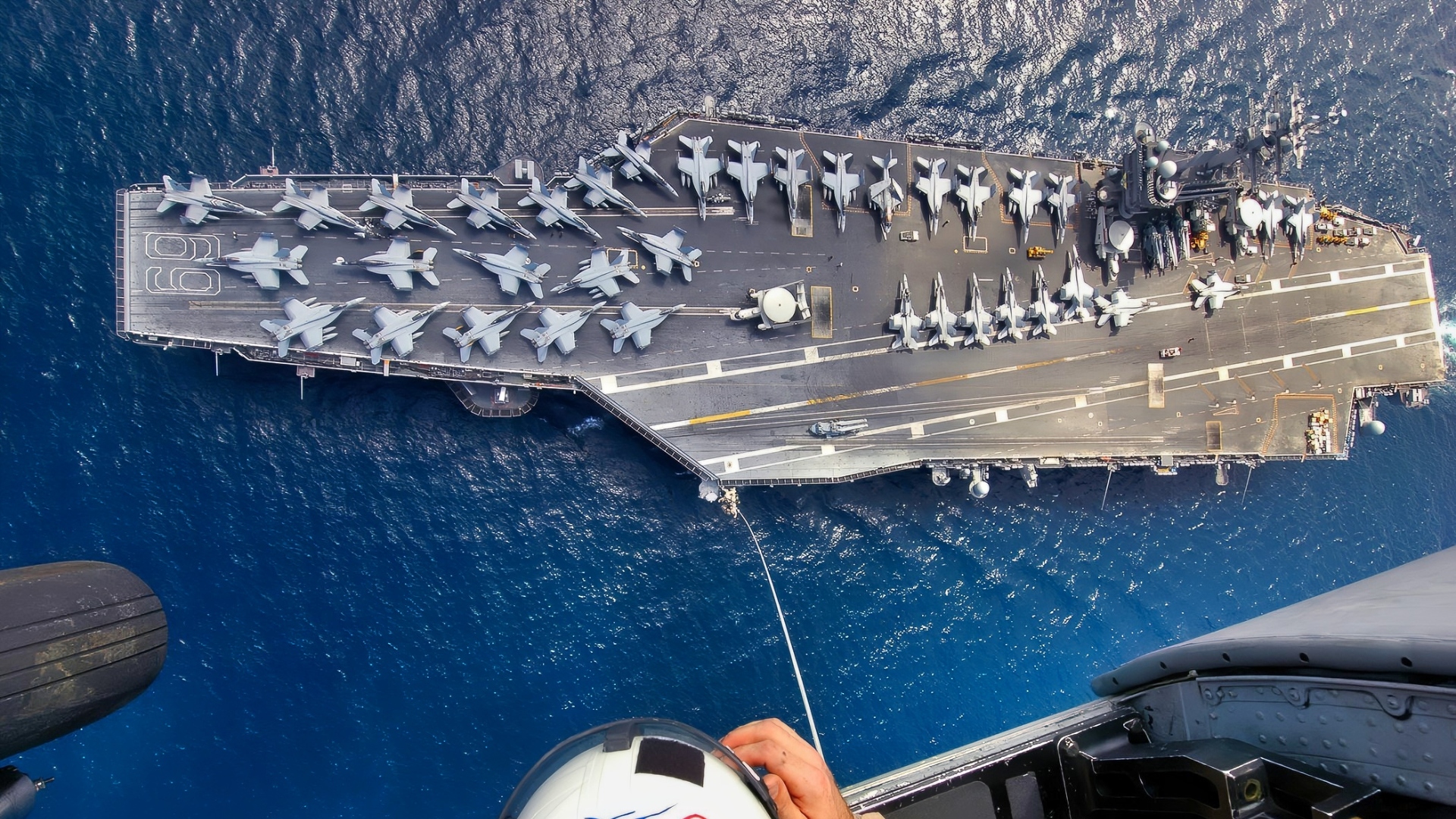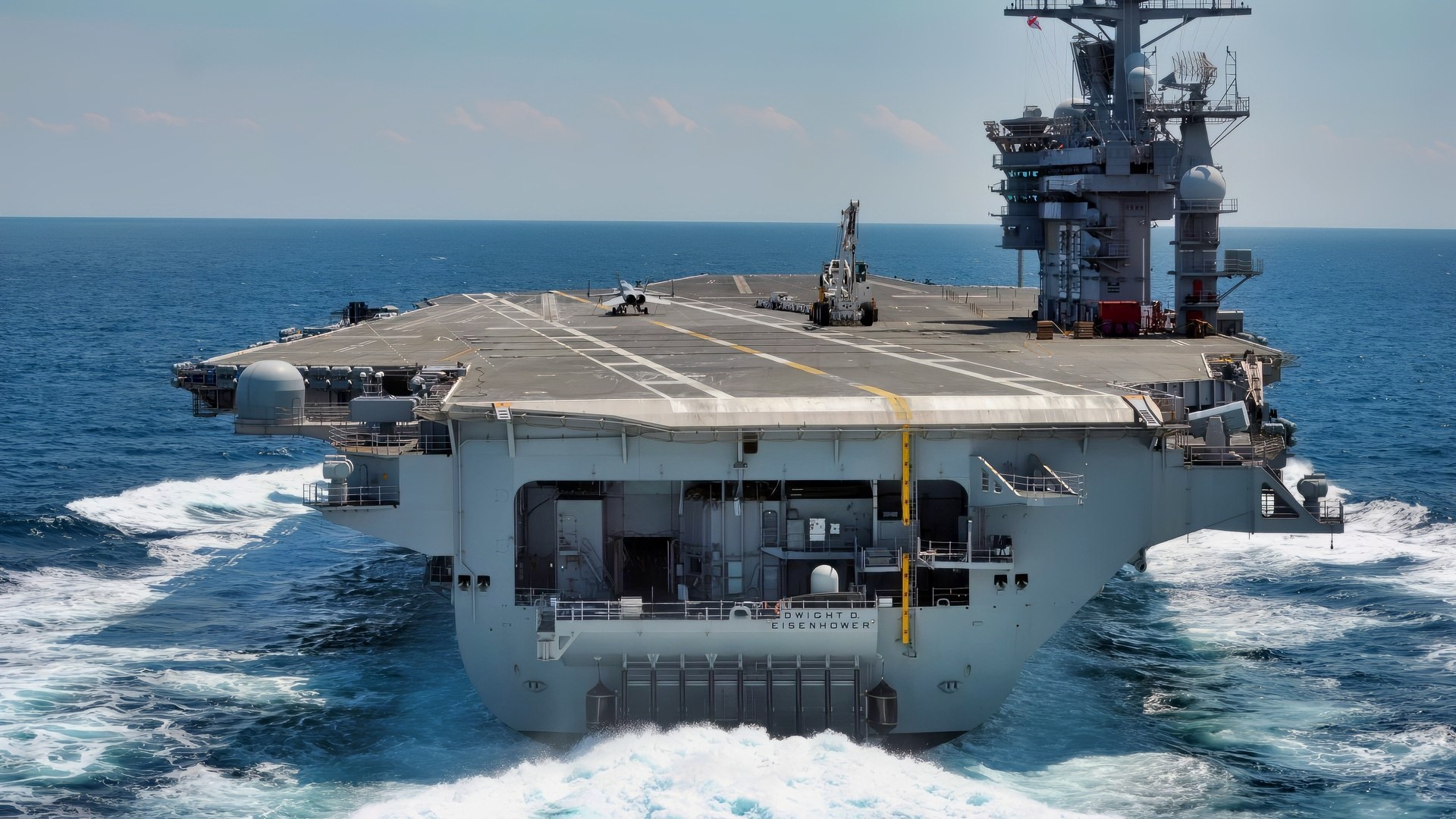Key Points and Summary – In a 1981 NATO exercise, a Canadian Oberon-class diesel-electric submarine reportedly slipped past a carrier screen and “sank” the USS Dwight D. Eisenhower with simulated torpedoes.
-The cost for such a carrier is over $5,500,000,000 to build, compared to the Canadian submarine, which comes in at $80,000,000.

The Nimitz-class aircraft carrier USS Dwight D. Eisenhower conducts rudder turns during sea trials.
-Whether or not every detail of that tale is on the record, the core lesson endures: quiet submarines are deadly.
-Since then, air-independent propulsion (AIP) has let conventional subs stay submerged for days with a whisper-low signature, and both friends and rivals have gotten better at undersea stalking.
-We trace the 1981 episode, explain why AIP boats are so hard to find, assess how a modern carrier strike group fights back, and ask what would really happen in a war.
The Aircraft Carrier “Kill” That Keeps Echoing
In 1981, during a big NATO exercise, a Canadian Oberon-class boat maneuvered into firing position and claimed a coveted scalp in peacetime training—the USS Dwight D. Eisenhower.
It was a scripted fight with safety rules and white-card umpires, but the message stung.
A small, patient submarine could stalk the centerpiece of American sea power and win—at least on paper.
If that sounds like bar-room lore, remember the wider context.

Explosive Ordnance Disposal 1st Class Christopher Courtney assigned to Explosive Ordnance Disposal Mobile Unit Six (EODMU-6), Det. 16 assist his team members during Special Purpose Insertion Extraction (SPIE) training from an SH-60 Seahawk helicopter. The Nimitz-class aircraft carrier USS Dwight D. Eisenhower (CVN-69) is deployed in support of Maritime Security Operations (MSO) and the global war on terrorism.
NATO war games in that era were already confronting a hard truth: in high-end fights, carriers might not always sail home.
The Oberon story endures not because of a press release but because it fit what operators were already learning—quiet beats big when conditions are right.
Why That 1981 Lesson Still Matters
The Oberons were no miracle machines.
They were classic diesel-electric submarines with disciplined Canadian crews, obsessive noise hygiene, and a talent for lurking in sound channels where shipboard sonars struggle.
In the constrained waters of an exercise box, those ingredients were enough to teach a painful lesson about humility.
Fast-forward four decades and the technology curve has bent further in the submarine’s favor.
The defining change is air-independent propulsion, or AIP. Instead of snorkeling every day to charge batteries—a dead giveaway—an AIP boat can remain submerged for a week or more at low speed while generating electricity quietly with a Stirling engine or fuel cells.
The result is a conventional submarine that, in the right conditions, is quieter than many nuclear boats when those nukes are running pumps and hotel loads. It’s a patient hunter that can sit in ambush, listen, and wait.

Nimitz-class carrier USS George H.W. Bush (CVN 77) transits the Atlantic Ocean while offloading munitions via helicopter to the world’s largest aircraft carrier, USS Gerald R. Ford (CVN 78), June 27, 2025. Gerald R. Ford, a first-in- class nuclear aircraft carrier and deployed flagship of Carrier Strike Group Twelve, incorporates modern technology, innovative shipbuilding designs, and best practices from legacy aircraft carriers to increase the U.S. Navy’s capacity to underpin American security and economic prosperity, deter adversaries, and project power on a global scale through sustained operations at sea. (U.S. Navy photo by Mass Communication Specialist Seaman Jarrod Bury)
Proof in Practice: When the U.S. Navy Rented a Problem
If you doubt how maddening AIP can be, recall what the U.S. Navy did in the mid-2000s: it rented the problem.
Sweden’s Gotland-class—AIP pioneers—deployed to San Diego so American carrier strike groups could spar against a best-in-class diesel boat.
The Gotland’s crew racked up enough “kills” in scripted runs to make believers out of skeptics.
The lesson then is the lesson now: you can’t brute-force your way past physics. A tiny acoustic target with the patience to wait and the endurance to remain submerged will get close more often than you’d like to think.
The 2025 Threat: Quieter Rivals, Busier Seas
Today that quiet is spreading. China’s navy fields modern non-nuclear submarines with AIP, and even when the engineering isn’t perfect, numbers and geography help.
The South and East China Seas offer reefs, currents, and layers that bend sound in the submarine’s favor. Russia, for its part, continues to export very quiet diesel-electric boats and operates some of the world’s most elusive nuclear attack submarines in the North Atlantic and Arctic.
Add the growing skill of partner navies—from the Baltic to the Indo-Pacific—and the undersea picture gets more crowded, more competent, and more complex.
Why Carriers Are Still Hard to Kill—And Why They’re Not Invincible
So would a modern carrier really be sunk?
It’s more complicated than the internet’s hot takes.
A carrier strike group is a layered ecosystem, not a single ship. Destroyers and cruisers tow sensitive arrays; helicopters dip active sonars and drop lightweight torpedoes; patrol aircraft seed the ocean with networks of sonobuoys and prosecute contacts from altitude. The carrier itself is wrapped in doctrine, geometry, and distance—operating at ranges designed to keep it outside likely ambush zones.
That said, there’s a difference between hard and impossible. The Navy’s experiment with a hard-kill anti-torpedo system fizzled years ago, and while soft-kill decoys and clever maneuvers remain, there is no silver bullet that swats a modern torpedo with the push of a button.
A submarine that solves the geometry—closing undetected inside weapon range, perhaps by lying motionless on batteries until the group passes—can create a nightmare in minutes. The defender’s job is to make that geometry as rare as a lightning strike by pushing the acoustic fight outward.
What Makes AIP Boats So Maddening to Find
Think of sound underwater like light in fog: it scatters, bends, and vanishes into layers. AIP boats exploit the fog. They minimize “indiscretion time” (the moments they must reveal themselves by snorkeling), float their machinery on shock-absorbing mounts, line their hulls with anechoic tiles, and creep at speeds where propellers don’t cavitate. In shallow, busy littorals—cluttered with commercial ships and uneven seabeds—the ocean gifts them camouflage. They don’t need to outrun a carrier; they just need to be quiet where the aircraft carrier plans to be tomorrow.
How a Strike Group Counters the Quiet
The playbook is evolving. Long-range patrol aircraft like the P-8A Poseidon tie together vast sonar fields, crunching buoy data to tease patterns out of noise. Helicopters from the escort screen dip and ping aggressively in likely approach lanes.

P-8A Poseidon. Image Credit: Creative Commons.
The destroyers themselves run integrated undersea warfare suites that fuse hull-mounted, towed, and variable-depth sonars with improved processing. Increasingly, unmanned systems—towed gliders, autonomous sensor nodes, and small crewless surface craft—extend the group’s ears beyond human endurance. It’s imperfect, but it’s layered, and layers are what you want when a single miss can mean a catastrophe.
Would 1981 Happen Again?
Could a Canadian-style ambush happen today in a training drill?
In the right patch of water, with the right crew and a little luck—yes.
But the bar is higher. The strike group’s outer zone is better instrumented, its airborne assets can search wider and faster, and commanders are more cautious about where they let an aircraft carrier roam.
Suppose a quiet sub gets inside weapon range. In that case, post-event analysis will likely trace the error to a chain of small breaks—an old towed array being down for maintenance, a missed buoy pattern, a helicopter diverted for another task. That is the essence of undersea warfare: many small things go right for a long time, and then—if you let them—one or two go wrong quickly.
The Real Lesson for 2025
It’s tempting to argue that aircraft carriers are obsolete because small subs can score simulated kills.
That goes too far. Carriers bring effects across domains—air defense, strike, surveillance, presence—that no single submarine can match. But the reverse claim—that carriers are untouchable—is equally wrong. The modern undersea threat turns every deployment into a chess match you can’t stop playing. The 1981 story survives not because it embarrasses the Navy, but because it disciplines it.
Where the Navy Should Go Next
First, treat the ocean as a sensor. That means more permanent acoustic arrays in chokepoints, more data fusion across aircraft and ships, and more automation to spot faint patterns invisible to tired human eyes at 0300.
Second, surge the airborne layer. The carrier’s own helicopters and the theater’s patrol aircraft are the only tools that can move fast enough to close on fleeting contacts.
Third, invest in hard-kill defenses that actually work. Torpedoes won’t get any dumber; ships need an answer beyond evasive turns and decoys.
Finally, train like it’s 1981 every day. Rent quiet adversaries, invite allies with world-class diesel boats, and create exercise rules that reward subs for patience and punish the surface force for complacency.
Why This Matters Far From the North Atlantic
The next dangerous encounter may not be in the open Atlantic at all.
In a crisis near Taiwan or in the South China Sea, non-nuclear submarines—even if less advanced than the Swedish or German benchmark—could lurk under busy shipping lanes and threaten a carrier’s freedom to maneuver.
In the High North, Russian boats can leverage cold, stratified waters and ice edges that break up sonar paths.
And in the Mediterranean, where depth and traffic vary by the mile, a disciplined AIP boat can make a strike group burn days on a single ambiguous contact. The geography changes; the math does not.
Back to the Beginning: Yes, Submarines Can Sink Aircraft Carriers
That old Oberon tale isn’t sacred scripture, but it captures something important: superiority at sea is not a trophy, it’s a behavior. In 1981, a small, quiet boat behaved better than a large, confident fleet for just long enough to win a scripted kill.

Norfolk, VA. (May 7, 2008)-The Virginia-class submarine USS North Carolina (SSN 777) pulls into Naval Station Norfolk’s Pier 3 following a brief underway period. North Carolina was commissioned in Wilmington, N.C. on May 3, 2008. (U.S. Navy Photo By Mass Communications Specialist 3rd Class Kelvin Edwards) (RELEASED)
In 2025, as AIP spreads and nuclear boats get stealthier, the only antidote is relentless humility backed by relentless investment. Carriers still matter; so does the silence that stalks them.
About the Author: Harry J. Kazianis
Harry J. Kazianis (@Grecianformula) is Editor-In-Chief and President of National Security Journal. He was the former Senior Director of National Security Affairs at the Center for the National Interest (CFTNI), a foreign policy think tank founded by Richard Nixon based in Washington, DC. Harry has over a decade of experience in think tanks and national security publishing. His ideas have been published in the NY Times, The Washington Post, The Wall Street Journal, CNN, and many other outlets worldwide. He has held positions at CSIS, the Heritage Foundation, the University of Nottingham, and several other institutions related to national security research and studies. He is the former Executive Editor of the National Interest and the Diplomat. He holds a Master’s degree focusing on international affairs from Harvard University. Email Harry: [email protected].
More Military
China’s New J-35 Navy Stealth Fighter Summed Up in 2 Words
China’s ‘Mighty Dragon’ J-20 Air Force Stealth Fighter Summed Up in 2 Words
China Is Trying to Turn the Indo-Pacific Into a Giant U.S. Navy ‘No-Go Zone’
$13 Billion Mistake? USS Gerald R. Ford Is the Navy’s Aircraft Carrier Agony
China’s ‘Thousands of Missiles’ Have a Message for U.S. Navy Aircraft Carriers











Chad Rowin
October 27, 2025 at 11:55 am
To be fair, that $5.5 billion dollar aircraft carrier was not sunk by an $80 million dollar submarine. It was taken down by a $1.5 million dollar torpedoe fired by an $80 million dollar submarine. So were the other ships in the fleet, sunk each by $1.5 million dollars of acoustic explosives.